
GoFlight
Flight booking experience
Project Type
UX Design Project
Date
Aug. 2024 - Mar. 2025
Location
Dublin, Ireland
Softwares used:
Context
As part of my UX Design Institute certification, I designed a high-fidelity prototype for a flight selection experience on a booking website. My process prioritized a user-centered approach, which included iterative usability testing, and was complemented by in-depth competitive analysis to uncover critical insights and inform design decisions that avoid common pitfalls and integrate best practices.
This project focuses on the initial three stages of the design process, Research, Define, and Prototype as part of the design process.

Research Block
Objectives
Identify best practices and usability issues in competitors' flight selection interfaces.
Identify Key User Pain Points and Frustrations within existing Flight Selection Processes
Determine User Expectations and Mental Models for an seamless flight selection experience
Uncover Opportunities for Innovation and Differentiation in the flight selection process
Research Plan
To achieve these objectives, I undertook a Competitive Benchmark analysis, using Nielsen's 10 usability heuristics as a guide, identifying common issues and best practices within the industry. I then conducted and analized Usability Tests from different airlines, paying attention to interaction and navigation problems users encountered, as well as their pain points and expectations during the booking process.
These findings, along with data I gathered for Affinity Map, were further enriched by conducting a User Journey analysis, specifically identificating user emotions and areas of frustration throughout their experience. All this information was then synthesized to highlight areas for improvement across various categories, ultimately leading to actionable insights.
Research Methods
Competitive Benchmarker
The primary objective of this analysis was to identify established best practices and conventions, as well as common usability issues in the industry.
My evaluation focused on the flight selection process, from the initial interaction with the search bar to flight and fare selection, and finally, booking confirmation.
Below is an analysis of three direct competitor airlines and one indirect competitor in hotel bookings.
Ryanair is a major European low-cost airline founded in 1985, headquartered in Dublin.
Iberia is the flag carrier airline of Spain, based in Madrid. It's a major player in the EU market.
Lufthansa is a German aviation group, also known as the Lufthansa Group, with global operations.
Mr & Mrs Smith is a travel club and booking platform specializing in hand-picked boutique and luxury hotels.
Ryanair Analysis

Home Page

Home Page
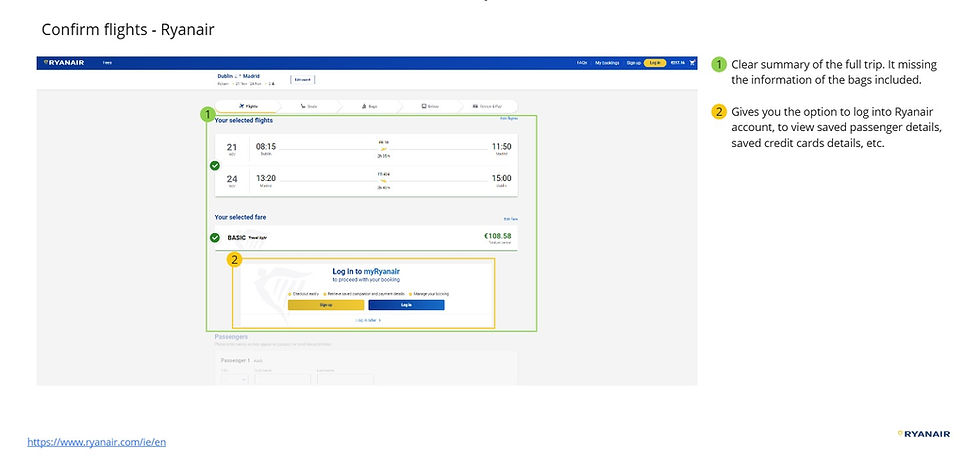
Review and Confirm

Home Page
Iberia Analysis




Lufthansa Analysis
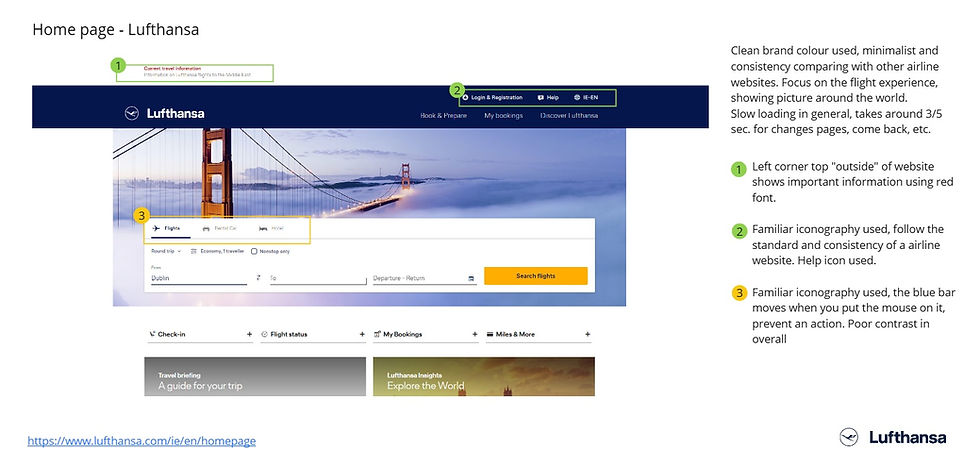



Mr & Mrs Smith Hotel Analysis

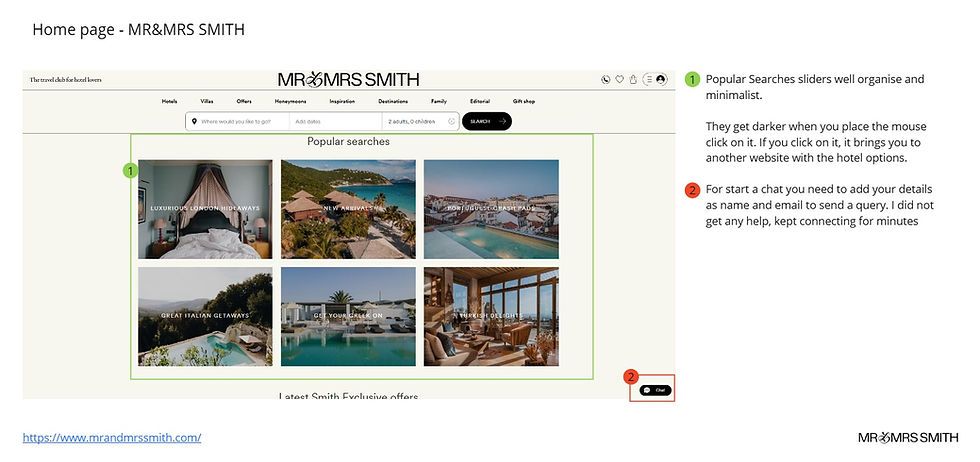
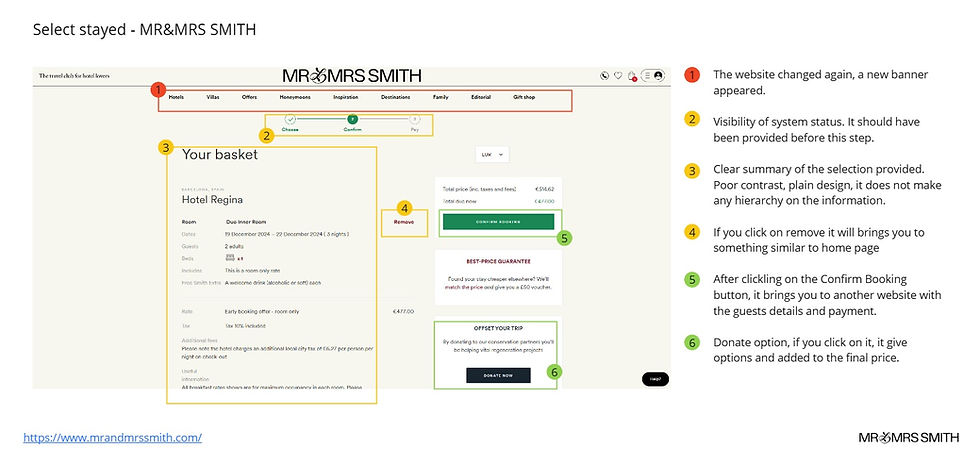

SWOT Analysis
I organized the key findings in the competitors analysis into the following chart, which groups together strengths, identifies weaknesses to avoid in a new flight search website, highlights crucial UX design opportunities in existing flight navigation, and pinpoints areas where new features and interactions can be innovatively addressed, all while considering potential external threats to the user experience.

Competitors Usability Test
This research presents key insights from usability testing conducted on competitor airline websites. The primary objective was to observe and document user interactions with the online flight booking process, focusing on the selection of round-trip flights. By analyzing participants' experiences navigating similar scenarios on these websites, my aim was to identify usability issues, areas of user frustration, and gather insights into user mental models and expectations.
I highlight the main Usability Issues and User Expectations identified and that are viable to adress in this project.
Te competitors analized were:

Usability Test Conducted - Ryanair
Usability Issues




Notes taking - Miro
Common problems:
-
Poor feedback, leading to repetitive actions
-
Slow process.
-
Confusing interactions, especially with pop-ups, calendars, and city selection, caused frustration.
-
Several eatures were unused because they were difficult to understand or find.
Other issues:
-
Lack of personalization, the website didn't recognize user data or preferences.
-
Poor visual design.
-
Ambiguous information about flight details, fare benefits, and baggage policies.
-
Led to unwelcome surprises at the end of the booking process.
User Expectations/Behaviours
Users want:
-
Clear and trust experience
-
Key information like stops, flight durations and fare differences presented upfront.
Before confirming a booking, users expect to:
-
Review a good flight summary.
-
A simple way to share flight details with others—a process they currently hack together using WhatsApp screenshots.
-
They prefer speaking with an agent instead of a chatbot.
-
They express a willingness to use filters in the future if they better understood the benefits.



Notes taking - Miro
Resarch Block (Analysis)
Affinity Diagram
The data collected from the Competitive Benchmark and Usability Testing were organized into an Affinity Diagram, which proved instrumental in identifying patterns and key insights related to common user frustrations and future design opportunities.

Part of Affinity Diagram - Miro
User Journey
This user journey map shows the emotional path of travelers, beginning with the initial Excitement and Anxiety of planning a trip with peers. This visual map helps us understand the feelings and identify the critical areas where we need to put more attention.


Part of User Journey Analysis - Miro
Key Insights
From the research analysis, I synthesized the information into six main insights. These findings will directly guide the design recommendations for developing the wireframes and, ultimately, the high-fidelity prototype.

Define
Wireframes
These wireframes are a direct result of my user research, where I discovered that a great booking experience must be both efficient and trustworthy. With that in mind, I have designed a solution that prioritizes clarity, trust and simplicity.
The design provides clear feedback while eliminating distractions to keep the user focused on their task. I have also focused on following established design conventions and using familiar language to create a comfortable experience. By ensuring important information is visible and easy to find, my proposal is a product that earns user trust and culminates in a smooth experience.
Finally, I have made accessibility a priority by utilizing high-contrast colors and bold fonts to ensure the experience is as seamless as possible for everyone.
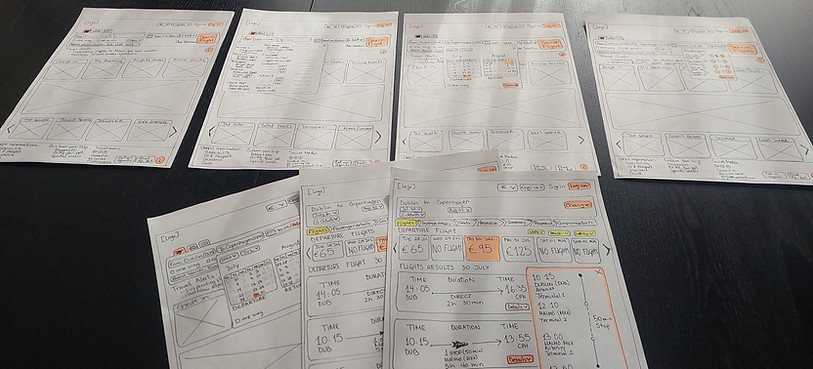
Prototype
Home Page
The home page proposal is designed with a focus on both accessibility and clear information hierarchy.
Key Improvements:
-
Enhanced Visual Clarity: I utilize strong contrast and bold typeface to ensure legibility and guide the user's eye efficiently.
-
Reduced Cognitive Load: Addressing user feedback about feeling overwhelmed, the design significantly reduces the information presented on the home page to the essentials.
-
Familiarity Meets Innovation: Maintaining the conventional flight search bar flow, iconography, and concepts found on established flight websites to unser user familiarity and minimize cognitive load.
-
Constant Support: Help and Support resources are made easily and consistently accessible to the user at all times.
Details

Search Flight Bar navigation
The design of the flight search bar is centered on a common, efficient flow that minimizes the number of clicks while consistently maintaining user control to prevent navigation errors.
Key Search Features:
-
Smart Origin Selection: The bar includes auto-recognition of the origin city. This, combined with showing only the destinations where the airline operates, builds user trust and prevents downstream booking errors.
-
Error Prevention & Guidance: Clear alert messages are implemented to guide the user on how to proceed, ensuring a smooth and error-free experience.
-
Calendar Flexibility: The calendar feature now includes a prominent "One-Way" toggle. This provides users with the immediate flexibility to adjust their search type without leaving the selection view.
-
Flexible Data Entry: Recognizing diverse user preferences, users have the option to type in or manually enter, cities and dates, giving them flexibility in how they interact with the fields.
To enhance the user experience, we've implemented smart options like "Recent Searches," but we've prioritized user control above all.
-
Recent Searches: Users will see their previous searches as convenient suggestions, but they retain the complete power to select them or ignore them.
-
Clear Selection: A straightforward "Clear Selection" option is readily available, allowing users to quickly start their search from scratch if they choose.
Flight Results & Selection
The Results Page is designed to provide immediate clarity and complete transparency, ensuring users have all the necessary information to make a confident decision.
Key Features and Rationale:
-
Trip Summary: The page immediately shows both the departure and return flights along with the final trip price. Crucially, the price is clearly indicated as "per person" to avoid any unpleasant surprises during checkout.
-
Prioritized Information: We prioritize showing the most relevant flight information upfront. However, users can access more granular details (e.g., layovers, aircraft type) via a non-intrusive pop-up window.
-
Fare Options: Fare comparisons follow the industry convention of a simple, side-by-side comparison table. The focus is on clarity, avoiding overwhelming users with excessive details.
-
Pricing Flexibility: Prices for surrounding days are easily accessible, allowing users to quickly assess potential savings by adjusting their travel dates.
Details

Conclusions and Future Outlook
Key Learnings & Reflection on Process
-
Deepen User Research: For a subsequent iteration, I would prioritize gathering more granular data by focusing on a specific user segment. This targeted approach would yield highly accurate insights, reducing assumptions and ambiguity in the design decisions.
-
Expand Project Scope (Full Funnel): Given a larger time allocation, the project scope would be extended to cover the entire booking funnel through to final payment. Analyzing the complete journey would ensure a seamless and robust solution from discovery to confirmation.
-
Validate with Testing: The immediate next step for this prototype is usability testing. Running validation tests is crucial for verifying the proposed solutions and gathering necessary feedback to inform the next phase of design iteration.
-
Figma Proficiency Growth: Coming from a background in Industrial Design and using tools like Adobe CC and 3D software, learning Figma was a rewarding challenge. While this project built a solid foundation, I plan to pursue advanced Figma training to more efficiently translate complex design ideas into polished, high-fidelity prototypes.
My studies in Industrial Design and my experience in Customer Experience confirms that the UX process—specifically the systematic gathering and synthesis of user insights—is a powerful methodology. It provides a robust, data-driven framework that successfully organizes ambiguous data and validates creative decisions across diverse projects.
This was a successful project for learning how to translate user needs into intuitive website interactions. Moving forward, I would certainly incorporate deeper research data and refine the final prototype to fully embody all discovered design recommendations.